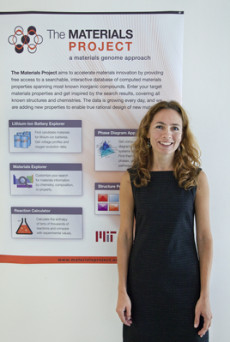Development of Advanced Materials Get Boost
The Materials Project of Berkeley Lab/MIT will work with Intermolecular Inc. to accelerate innovation.
June 24, 2013
By Julie Chao
Contact: cscomms@lbl.gov

Berkeley Lab scientist Kristin Persson co-founded the Materials Project, to accelerate discovery of new materials. (Photo by Roy Kaltschmidt/Berkeley Lab)
The Materials Project—an open-access Google-like database for materials research developed by Lawrence Berkeley National Laboratory (Berkeley Lab) and the Massachusetts Institute of Technology (MIT)—is working with Intermolecular, Inc. to enhance the tool’s modeling capabilities and thus accelerate the speed of new material development by tenfold or more over conventional approaches. New materials are key to addressing challenges in energy, healthcare and national security. The Materials Project is hosted on the National Energy Research Scientific Computing Center's (NERSC) Science Gateway.
The White House Office of Science and Technology Policy highlighted the news in a release today about the Materials Genome Initiative, a public-private endeavor launched by the President that aims to cut in half the time it takes to develop novel materials that can fuel advanced manufacturing and bolster the 21st century American economy.
“The Materials Project was designed to be an open and accessible tool for scientists and engineers working in both the public and private sectors, and we are pleased that Intermolecular has recognized the power of these computational predictions to accelerate materials discovery,” said Don DePaolo, Associate Lab Director for Energy and Environmental Sciences at Berkeley Lab. “The contribution of experimental data from Intermolecular represents an important step forward for the Materials Project in its utility and service to the broader materials research community. We believe this is a win-win for both industry and science.”
Using conventional approaches, it takes about 18 years to conceptualize and commercialize a new material. The Materials Project is meant to address this bottleneck by using a genomics approach to materials science—it uses supercomputers to characterize the properties of all known materials and thus takes some of the guesswork out of materials design. Intermolecular, based in San Jose, California, will provide data from its proprietary high-throughput combinatorial experimentation and characterization toolset to the Materials Project to enable it to develop better predictive materials models.
“Access to high-quality experimental data is absolutely essential to benchmark high-throughput computational predictions for any application,” said Berkeley Lab scientist Kristin Persson, co-founder of the Materials Project. “We begin every materials discovery project with a comparison to existing data before we venture into the space of undiscovered compounds. This is the first effort to integrate private sector experimental data into the Materials Project, and could form the basis of a general methodology for integrating experimental data inputs from a wide-range of scientific and industrial sources.”
Persson said having experimental data in the Materials Project can help in two ways. First, they will use the data to refine their methodologies if they find their predicted values are off. “It will improve our models,” she said.
Secondly, the experimental data may be displayed side-by-side with the predicted values. “It builds confidence in our predictive models for our users if they can see the values agree,” she said.
The Materials Project has grown rapidly since it was launched in late 2011. The number of materials in its database has doubled from 15,000 to more than 30,700, and it has attracted more than 4,000 users. Just over half of the users are from academia, about 22 percent from industry and about 20 percent from government or other sectors.
What’s more, an increasing number of those users are return users. “We’re starting to see more of a growing community, which is really exciting, and people contributing voluntarily to the code base, as it’s open source,” Persson said.
The team is also working to broaden the scope of the properties it covers, from just bulk properties—such as density, voltage, phase stability—to include surfaces and defects. While bulk properties are key in some applications, such as batteries, surfaces are important in catalysis and defects are important for electronic properties.
More information:
Accelerating Advanced Material Development
NERSC Helps Develop Next-Gen Batteries
About NERSC and Berkeley Lab
The National Energy Research Scientific Computing Center (NERSC) is a U.S. Department of Energy Office of Science User Facility that serves as the primary high performance computing center for scientific research sponsored by the Office of Science. Located at Lawrence Berkeley National Laboratory, NERSC serves almost 10,000 scientists at national laboratories and universities researching a wide range of problems in climate, fusion energy, materials science, physics, chemistry, computational biology, and other disciplines. Berkeley Lab is a DOE national laboratory located in Berkeley, California. It conducts unclassified scientific research and is managed by the University of California for the U.S. Department of Energy. »Learn more about computing sciences at Berkeley Lab.







